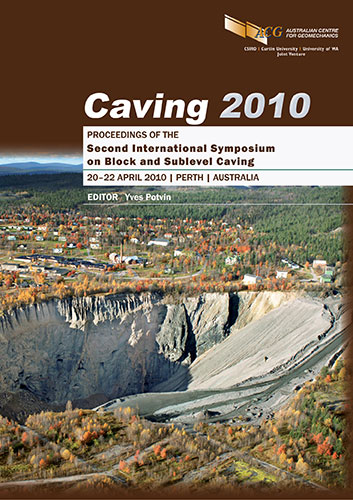Development of the kinematic model to rapidly simulate the flow of caved rock for block caving

|
Authors: Castro, R; Tamburrino, A; Fernandez, F Paper is not available for download Contact Us |
DOI https://doi.org/10.36487/ACG_rep/1002_40_Castro
Cite As:
Castro, R, Tamburrino, A & Fernandez, F 2010, 'Development of the kinematic model to rapidly simulate the flow of caved rock for block caving', in Y Potvin (ed.), Caving 2010: Proceedings of the Second International Symposium on Block and Sublevel Caving, Australian Centre for Geomechanics, Perth, pp. 583-591, https://doi.org/10.36487/ACG_rep/1002_40_Castro
Abstract:
In recent years, new efforts have been made into the investigation of gravity flow of caved rock for block caving methods using different research approaches. These include physical modelling, numerical modelling and full scale tests. One of the practical aims of studying the flow characteristics of the caved rock is to evaluate ore recovery, dilution and mixing resulting from given draw control and production level design practices. To date, the main tool used to predict mixing and recovery for mine long-term planning purposes in block caves is the volumetric model or template mixing approaches. From the various emergent numerical approaches to simulate the flow of the caved rock, the kinematic model (KM) has been proposed to describe the granular flow in silos and bins. In this paper we developed an improved kinematic model (IKM) and used it to replicate the flow for block caving using several drawpoints. The mixing which is generated from the flow was validated using data coming from an extensive experimental work. Results indicate that the calibrated model could simulate the flow using the kinematic approach in both isolated and multiple draw conditions.
© Copyright 2026, Australian Centre for Geomechanics (ACG), The University of Western Australia. All rights reserved.
View copyright/legal information
Please direct any queries or error reports to repository-acg@uwa.edu.au
View copyright/legal information
Please direct any queries or error reports to repository-acg@uwa.edu.au